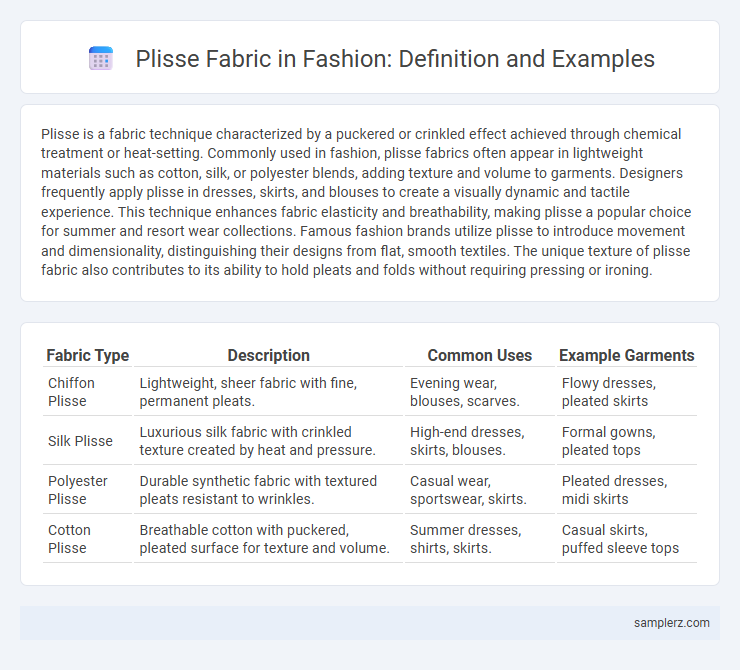Plisse is a fabric technique characterized by a puckered or crinkled effect achieved through chemical treatment or heat-setting. Commonly used in fashion, plisse fabrics often appear in lightweight materials such as cotton, silk, or polyester blends, adding texture and volume to garments. Designers frequently apply plisse in dresses, skirts, and blouses to create a visually dynamic and tactile experience. This technique enhances fabric elasticity and breathability, making plisse a popular choice for summer and resort wear collections. Famous fashion brands utilize plisse to introduce movement and dimensionality, distinguishing their designs from flat, smooth textiles. The unique texture of plisse fabric also contributes to its ability to hold pleats and folds without requiring pressing or ironing.
Table of Comparison
| Fabric Type | Description | Common Uses | Example Garments |
|---|---|---|---|
| Chiffon Plisse | Lightweight, sheer fabric with fine, permanent pleats. | Evening wear, blouses, scarves. | Flowy dresses, pleated skirts |
| Silk Plisse | Luxurious silk fabric with crinkled texture created by heat and pressure. | High-end dresses, skirts, blouses. | Formal gowns, pleated tops |
| Polyester Plisse | Durable synthetic fabric with textured pleats resistant to wrinkles. | Casual wear, sportswear, skirts. | Pleated dresses, midi skirts |
| Cotton Plisse | Breathable cotton with puckered, pleated surface for texture and volume. | Summer dresses, shirts, skirts. | Casual skirts, puffed sleeve tops |
Introduction to Plissé: A Unique Fabric Texture
Plisse fabric features a distinctive puckered texture created through a chemical treatment that shrinks parts of the material, producing raised ridges. Commonly used in fashion for lightweight garments such as blouses, dresses, and skirts, plisse adds visual interest and breathability. Brands like Chanel and Dior often incorporate plisse to enhance the tactile dimension and aesthetic appeal of their collections.
The History and Evolution of Plissé in Fashion
Plisse fabric, characterized by its puckered, crinkled texture, originated in the 18th century as a lightweight alternative to pleated textiles, gaining popularity through its use in Victorian-era women's garments. The technique evolved from chemical treatments of cotton and silk, creating durable, textured finishes that required minimal ironing, aligning with the period's emphasis on ornate yet practical fabrics. Modern fashion designers continue to reinvent plisse by incorporating synthetic blends and advanced fabric technologies, maintaining its relevance in contemporary haute couture and ready-to-wear collections.
How Plissé is Created: Techniques and Methods
Plisse fabric is created through a heat-setting process that uses chemical treatments or mechanical puckering to form permanent creases and textured patterns. Techniques such as applying caustic soda in specific areas cause the fabric to shrink selectively, producing its characteristic crinkled effect. This controlled puckering enhances the material's elasticity and visual depth, making plisse a popular choice in fashion for adding dimension and comfort to garments.
Iconic Plissé Garments Throughout Decades
Iconic plisse garments such as Issey Miyake's Pleats Please collection revolutionized fashion by combining artistry with innovative fabric techniques, creating garments that maintain structure while allowing fluid movement. The textured, accordion-like folds of plisse fabric have been a hallmark in vintage Dior dresses from the 1950s, emphasizing elegance and volume without added weight. Contemporary designers continue to use plisse in flowing skirts and blouses, highlighting its timeless appeal and adaptability across fashion decades.
Plissé in Modern Runway Collections
Plisse fabric, characterized by its finely pleated texture, features prominently in modern runway collections by designers such as Issey Miyake and Valentino, who utilize its lightweight structure to create dynamic, sculptural silhouettes. The fabric's ability to hold intricate pleats without additional heat-setting treatments makes it ideal for innovative draping and movement on the catwalk. Contemporary fashion showcases plisse in diverse garments, from flowing dresses to structured skirts, emphasizing texture and volume as key trends for the season.
Best Fabrics for Achieving Plissé Effects
Lightweight cotton and polyester blends are among the best fabrics for achieving plisse effects due to their ability to hold puckered textures without losing shape. Silk and chiffon also work well for delicate, sheer plisse designs, offering a soft drape and elegant sheen. Fabrics with a slight stretch or synthetic content enhance the durability of plisse textures, making them ideal for fashion pieces requiring both structure and flow.
Styling Tips: Incorporating Plissé into Your Wardrobe
Plisse fabric adds texture and dimension to fashion ensembles, making it ideal for flowy skirts, blouses, and dresses that catch the light with subtle shimmer. Styling tips include pairing plisse skirts with fitted tops to balance volume, or layering plisse blouses under structured blazers for a polished yet playful look. Neutral tones and soft pastels in plisse enhance versatility, allowing easy transition from casual daywear to elegant evening attire.
Plissé in Sustainable and Eco-Friendly Fashion
Plisse fabric, characterized by its textured, crinkled surface created through a heat-setting process without chemical treatments, offers a sustainable alternative in eco-friendly fashion by reducing water and energy consumption during production. Designers increasingly incorporate plisse into collections emphasizing natural fibers like organic cotton and Tencel, enhancing biodegradability and lowering environmental impact. This innovative fabric choice supports the slow fashion movement by promoting durability, comfort, and stylish versatility while minimizing waste.
Celebrity Style: Famous Looks Featuring Plissé
Celebrity style frequently showcases plisse fabric in iconic outfits, such as Rihanna's pleated maxi dress at the Met Gala and Zendaya's shimmering plisse gown at the Oscars. This lightweight, textured fabric adds dynamic movement and visual depth, making it a favorite on red carpets and fashion runways. Designers like Valentino and Gucci often incorporate plisse into their collections, highlighting its versatility and elegant appeal.
Care and Maintenance Tips for Plissé Fabrics
Plisse fabrics, characterized by their distinctive crinkled texture, require gentle care to preserve their unique pleated effect and prevent flattening. To maintain plisse, wash the garment in cold water on a delicate cycle or hand wash, avoiding high heat and aggressive agitation. Air drying flat or hanging can help retain its shape, while ironing should be done cautiously on the reverse side with low heat to avoid damaging the texture.

example of plissé in fabric Infographic
 samplerz.com
samplerz.com